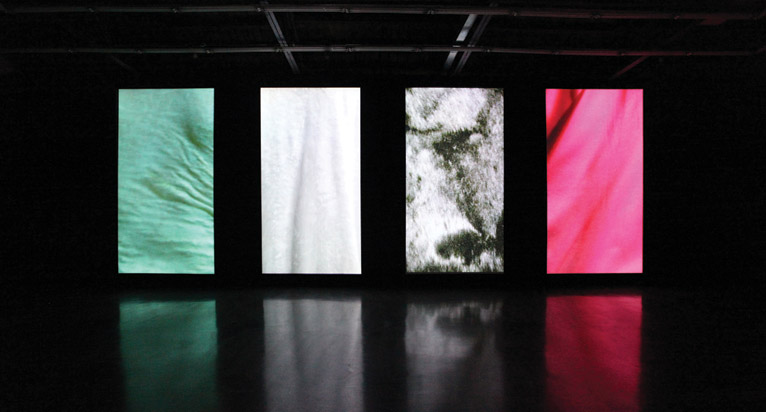HU XIAOYUAN & LIANG WEI
| December 1, 2010 | Post In LEAP 6

Hu Xiaoyuan and Liang Wei’s solo exhibitions opened successively in 798; separate spaces exhibited both of the artists’ four most recent video installation pieces. The works of the two artists not only are of similar volume, but also similarly feature the use of multi-channel monitors. Both made coinciding choices regarding form, electing to embody the kind of delicacy called forth by the title of Liang Wei’s title, “In Between.” For audiences, these choices made for a test of the extremes of visual sensitivity; the two artists may have separate origins, but their shared acumen and awareness when it comes to “form,” along with the kind of work that results—the rhythm billowing subtly through each frame, the experience of life extractable out of each and every minute detail—require of an audience a high degree of perspicacity. It follows that the work of the two artists caters to a smaller niche.
Hu Xiaoyuan seems to have been able to detach from concrete experience, turning to abstract topics such as time, space, and existence. The four-channel projection I Don’t Know How Long You’ve Been Walking On, and I Don’t Know Where You’re Going (all works 2010) occupies the wall of the main exhibition hall. Each panel records the rhythmic, rippling, side-to-side movement produced in folds of clothing worn by four different walkers shot from behind. Although different textures and gaits are distinguishable among the rhythm and tone of each panel, Hu uses inertia—almost turning the work into still life—as a way to declare the nothingness inherent in time and space. This method similarly comes through in Liang Wei’s series of three-channel videos, Gesture 2: three parallel black-and-white triptychs record three different actresses as they rehearse the same repetitive scene; in a sluggish state, they move back and forth between being seemingly lost in thought and being seemingly at a loss altogether. In reality, it is just that they have been placed within a static environment. A method like this either leads an audience to call both the artist’s motives and her point of departure into question, or it inspires an audience to search for meaning.
Hu Xiaoyuan tends more toward the analysis of knowledge and the expression of the impersonal. She enacts the representation of elements of visual pleasure, as with Where is There, where two bands respectively record the trajectory of time and space under parallel conditions; looking at its surface, the formal aesthetic of the fluctuating geometric shape assumed by the center of the tableaux is the leading feature of the work; in reality it is the artist’s hidden subconscious response to this speculative content. No Reason Why is both an inquiry into and an escape away from “meaning;” meaning is hidden within a dramatized scenario, manufactured as a readily transparent optical illusion. A Seamless Distance—comprised of two pairs of four-channel installations facing one another—raises a rhetorical question in its very set up, by demonstrating the juxtaposition of distance and time. The issues raised by these pieces intimately relate to the internal reflections of the artist; they constitute an island of thought unto their own.
Liang Wei more directly traffics in collective fear and hesitation. She puts life’s duality on display: “The grand narrative constructs our exterior context, while our internal processes are concealed by caution, and thus appear only through conditions of nebulous obscurity.” Breathing narrates the relationship between time and space, and next the merger between this relationship and the individual; the two-channel video, Bubble takes a river pollution incident as its object, showing it repeatedly from varying angles; then there is Midnight, which coldly reveals the ghost of the last century’s industrial utopia, as well as the historical residue it has left behind. Liang Wei takes a sense of lurking crisis and transforms it into film. Compared with Hu Xiaoyuan, she seems to act with more prudence when it comes to stretching the possibilities of language. Zhang Xiyuan

